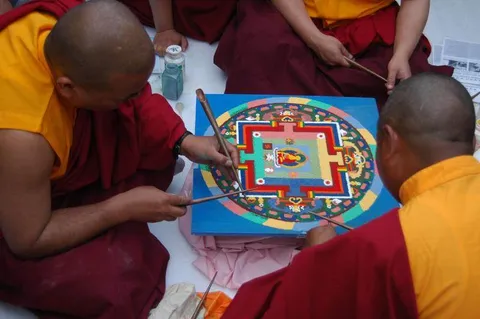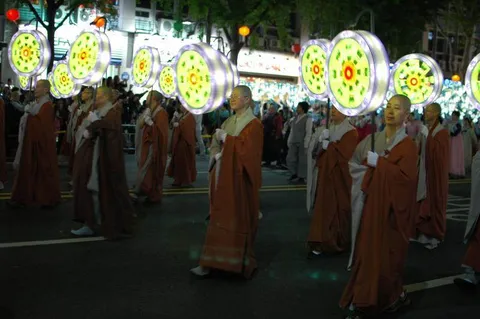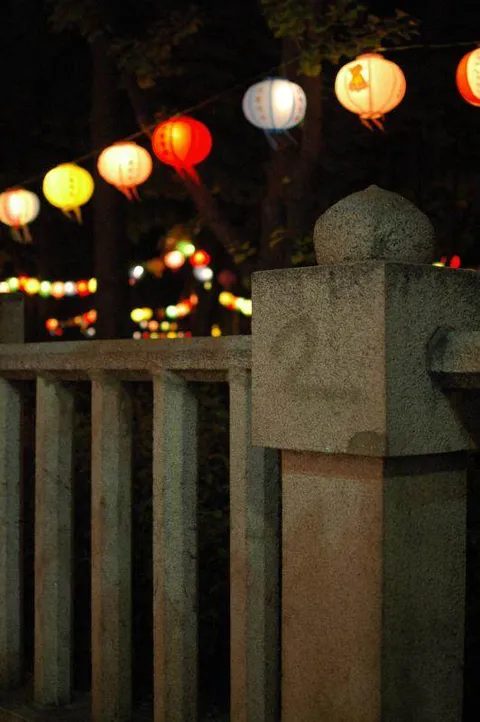
As in years past, the 연등회 (Yeon Deung Hoe, or Lotus Lantern Festival) is an excellent, if overly touristy, chance to learn more about one of the world’s oldest religions. A folk festival that has origins in the Goryeo period continued as the Lantern Celebration in the Joseon Dynasty (광등노리), and continues as a social festival to this day. The religion and reverence, however, seems to get lost amidst the hubbub of making paper lotus flowers, candles, and a hundred other things.
The event started in the afternoon, with dozens of tents offering arts, crafts, and information.

Say, perhaps, you want to make a paper lotus lantern…

…or a screen ink print…

…or make a wish to tie onto any of the strings, or dozens of other arts and crafts projects. I never knew Buddha was so artistically inclined.

No idea why a lion was posing with a ‘Good Hands Africa’ at a Buddha’s Birthday festival. What the Kimchi?

A bit more traditional – a large-scale jump rope where people just ‘jumped in’.

One highlight of the afternoon – an excellent drumming performance. Not sure I could identify the different types of drums, but the sound was tight and attracted a large crowd.
Shortly after the drumming came a Korean costume / mask performance. Since the performance was narrated in Korean, I have little idea about the meaning of the different characters:



The half-hour show had a wide variety of characters – cutting it down to three pictures for the sake of keeping your attention was hard 🙂

Spreading sand – one grain at a time. Even for these masters of patience it takes house to create a mandala.

An art project for the grown-ups with a steady hand – paint a Buddha, just follow the lines.

We finally ended up at the temple – running into FeetMan Seoul (AKA the Metropolitican) while there. The scene was chaotic – hundreds of people running around trying to get lanterns and everything set up for the parade coming up soon.
While the festival attracted a large foreigner crowd, the whole thing seems a bit… fluffy. Much like Christmas in the US, the reason for the season has been lost – it’s a family outing, not a reverential time. Even those trying to be reverential at the temple had a tough time navigating the colorful lanterns (still packaged five to a plastic bag) and the photographers going for the money shot.

When it was time for the Lotus Lantern Festival Parade to start, the Lady in Red and I found some seats on an underground market entrance; unless you’re in the front row you’ll need to be above the standing crowd.

The first thing to be aware of is the enormity of the crowd – you’re competing not only with locals, but with the sizable foreigner crowd as well. The second thing to be aware of is the huge number of parade walkers – although the most interesting exhibits are often the lanterns, watching legions of monks, nuns, and so on reminds you of how large this parade really is.

Buddha on a throne.

More than a few white elephants made an appearance, courtesy of different temples. In case you weren’t a Buddhist Studies major, a white elephant is a symbol of mental strength and have the power to produce rain. See this academic work for plenty more.

FIRE! From a peacock?

Shiny.



Here there be dragons! From one Buddhist website:
Dragons are shape shifters, able to transform at will, from as small as the silkworm to a giant that fills the entire sky. Dragons are depicted in one of two colors, green or brown. The green, or azure dragon of Buddhism ascends into the sky at the spring equinox; it represents the light’s increasing power in springtime and the easterly direction of the sunrise. The brown dragon is the autumn equinox, when it descends into a deep pool, encasing itself in mud until the next spring, but its spirit is still with the practitioner bringing wealth and health. The pearls, or jewels clutched in the claws of the dragon represent wisdom and health. The dragon can control the weather by squeezing the jewels to produce dew, rain or even downpours when clutched tightly. The dragon is the vehicle of Vairochana, the white Buddha of the center or the east.

Nothing like cartoon characters and the baby Buddha on the same float.

It takes quite a few people to pull some floats. Note the graceful dancer on the lotus flower.


It’s kind of a shame that the ‘big belly Buddha’ is one of those images a lot of people get when they think of the Buddha.
After an hour and a half of lanterns and endless thousands of people walking down the street, the parade ended and the closing ceremony began. That was our cue to head for the subway. Along the way, we ran into Roboseyo and ZenKimchi, who were also enjoying the parade elsewhere along the route. We meandered down towards Tapgol Park, where a number of lanterns lit up the darkened park:

My dear readers, this parade is highly recommended as one of the few events Seoul puts on that’s worth attending year after year. The afternoon festival is nice, if increasingly touristy, but the parade continues to shine.



ah ha … i was there earlier than you. I found it to be a great festival. I think if you wanted a quiet and meditative festival…going to an off-site temple celebration might have been better. This was definitely geared towards tourism.
I liked the variety of Buddhist representation. Really showed how this religion has spread and changed throughout time.
Seriously, I filled my 16 GB card >< First time that happened 😛 Going through the pics is definitely the hardest part.
I also liked the variety of Buddhism represented.
The most frustrating thing was that the parade split into two, so the main parade didn't come by where I was ><